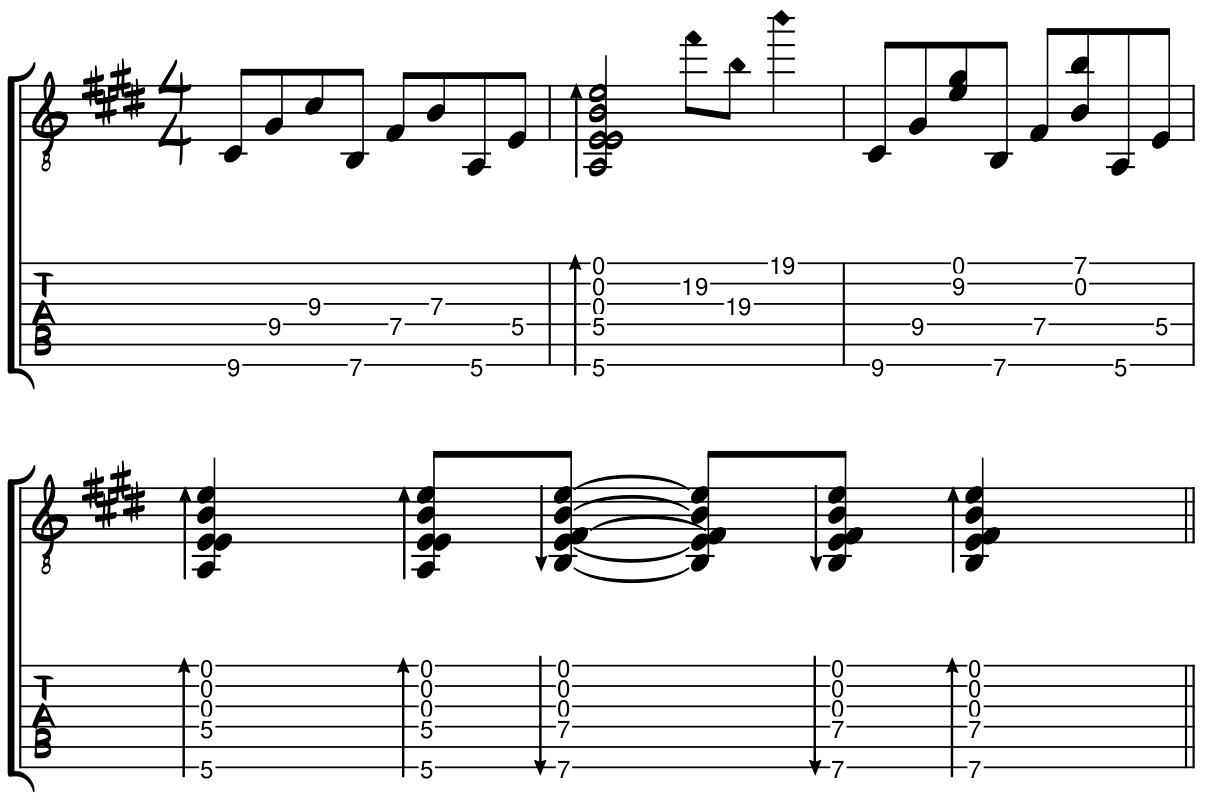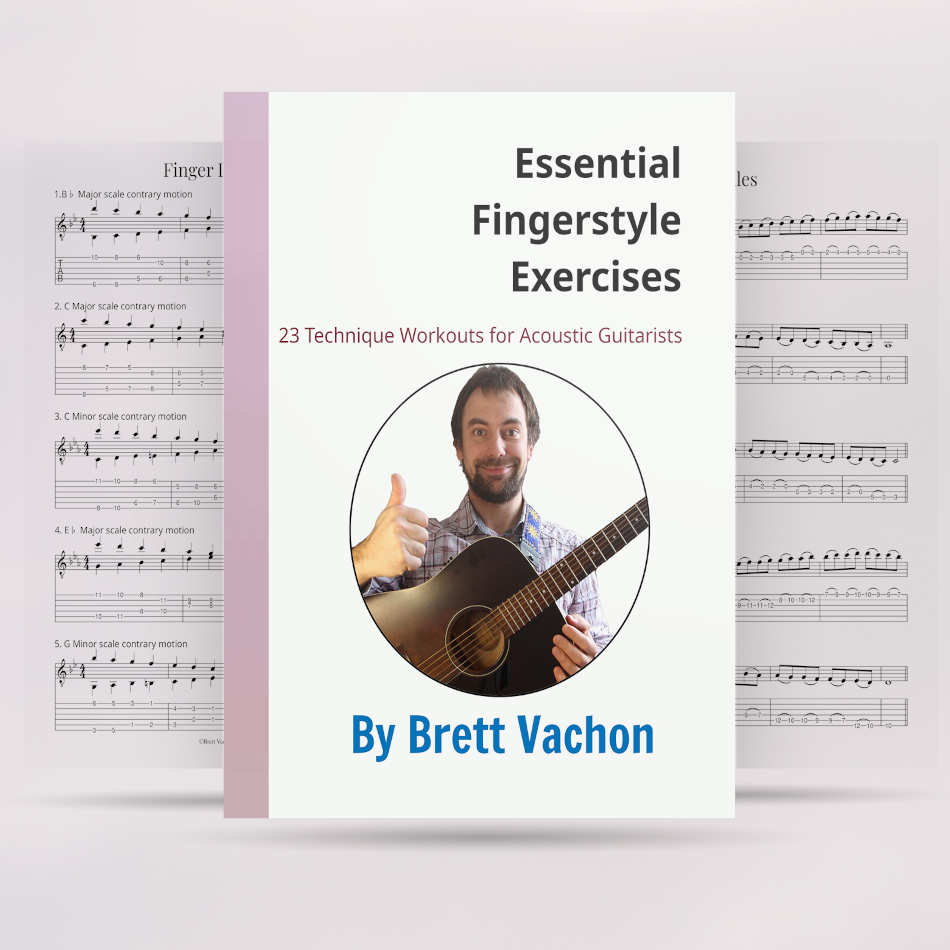Let's explore open E tuning, a rich, full alternate tuning which Sungha Jung uses for certain songs.
Open E major is a type of Open tuning, which means that you can create a chord just by strumming the open strings.
In the case of Open E tuning, the chord produced when you strum the strings is the E Major chord.
Unfortunately, most guides that show you how to use Open E tuning don't show the best variety of Open E, which I call Open Low E Major tuning. This is the tuning that sounds best for fingerstyle guitar and the one Sungha Jung uses in his songs.
What Is Open E Tuning?
If you are in Open E tuning, this means that your guitar strings are tuned to one of these three pitches: E, G sharp and B.
In all of the guides to this tuning that I have seen, the strings are tuned to the following pitches, from lowest to highest:
- String ① is tuned to E4
- String ② is tuned to B4
- String ③ is tuned to G♯3
- String ④ is tuned to E3
- String ⑤ is tuned to B2
- String ⑥ is tuned to E2
Notice that these pitches are exactly the same as for Open D tuning, except that they are all raised a whole step.
In fact, if you want to use this version of Open E tuning for your fingerstyle guitar playing, it is far better to tune into Open D tuning and slap a capo on the second fret.
Furthermore, I think it is very bad to tune your guitar higher than the pitches in standard tuning. To reach this Open E tuning, you will have to tune three of your strings to higher pitches, which I do not recommend you do, ever.
I talk more about tuning your guitar in my online course, Play Fingerstyle Guitar Now!
Thankfully, there's another version of Open E tuning which I do recommend you learn which is called Open Low E Major tuning.
What Is Open Low E Major Tuning?
Open Low E tuning involves tuning the strings of the guitar to the pitches E, G♯, B, E, B, E, from the lowest string to the highest string.
In Open Low E Major tuning, the strings are tuned to the following pitches, from lowest to highest:
- String ① is tuned to E
- String ② is tuned to B
- String ③ is tuned to E
- String ④ is tuned to B
- String ⑤ is tuned to G♯
- String ⑥ is tuned to E

How to Adjust the Strings to Open Low E Tuning
If you are starting from Standard Tuning, you will have to change the pitches of three of your strings of your guitar.
- String ① (high E) No change
- String ② (B): No change
- String ③ (G): Down 1½ step, from G to E
- String ④ (D): Down 1½ step, from D to B
- String ⑤ (A): Tune down ½ step to G♯
- String ⑥ (low E): No change
Starting from standard tuning, lower the third string from “G” to “E”. Play the sixth or first strings as you lower the third string. You will hear the beats which will slow down and gradually disappear as you approach the note “E.
Next, you must lower the fourth string from “D” to “B”. You can use the second string as your reference this time.
Pluck the second and fourth strings simultaneously, and lower the fourth string, all the while listening for the beats. They will disappear when the fourth string lowers to the proper pitch, which is the note B.
The difficulty here is in lowering the A string to G sharp. You need to lower the string by a semi tone. This semitone or half step is the distance between two notes on adjacent frets. Since we can’t use an open string as a reference, the note fretted at the sixth string fourth fret will be our G sharp as a reference. Be careful not to lower the fifth string beyond the half step interval.
Place your finger on the sixth string at the fourth fret and pluck it at the same time as the open fifth string. You will immediately start to hear the beats as you lower the fifth string because they are only a semitone apart.
Remember, if you turn the tuning peg and it becomes more difficult to turn, you are most likely adding tension to the string. If you are not sure in which direction you should turn the tuning pegs, notice how easily the peg turns when you tighten versus loosen the peg.
How To Use Open E Tuning for Epic Fingerstyle Songs
Open tunings allow you to use guitar harmonics much more readily and much easier than with standard tuning.
For instance, you can use percussive harmonics often, and the open tuning means that you can produce a major chord simply by slapping the guitar at the 12th fret.
The song On Cloud Nine uses Open Low E tuning, and Felicity by Sungha Jung uses Open Low F tuning, which is like Open Low E major tuning except raised by a half step. Again, I usually don’t recommend tuning up because this can cause you to break your guitar strings if you aren’t careful.
I play the song Felicity using the Open Low E tuning raised a half step by putting a capo on the first fret.
The Problem With Open E Tuning
As with other open tunings, you are limited to the key that your guitar is tuned in with the open tuning. In this example, if you are using open low E tuning, you'd better hope your song stays in E major and doesn't modulate.
Chord shapes are also different, but they tend to be simpler with an open tuning. Because of the alternate tuning, you will have to learn where to place the fingers in a new position and you cannot rely on your previously learned chord shapes.
Song In Open Low E Tuning: To The Nines
This song is in Open Low E tuning and demonstrates the advantage of this wonderful alternate tuning.

The song Two The Nines uses chord shapes which are found in the song On Cloud Nine by Sungha Jung.
For more easy to play songs like this one, check out my course Play Fingerstyle Guitar Now!



